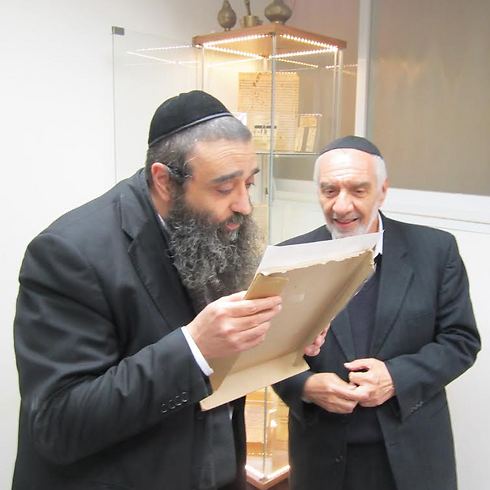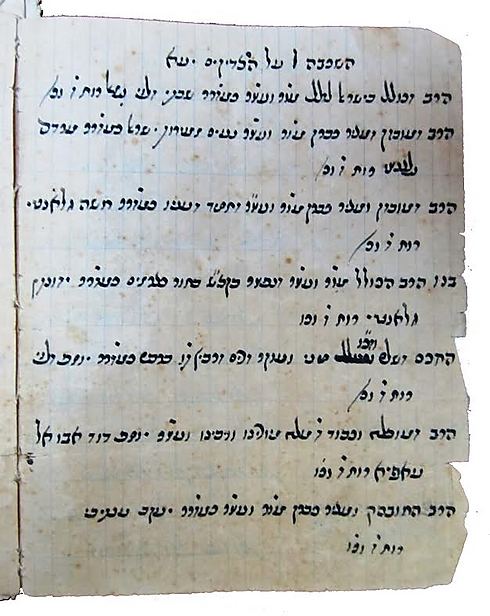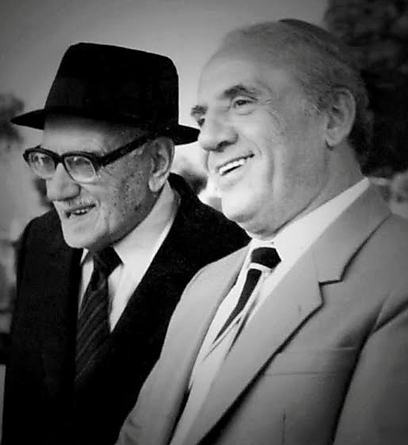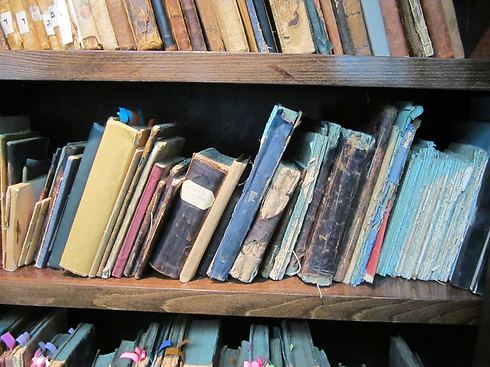Rabbi Moshe Chadid is doing the work of an academic department with his two hands: Carefully preserving the Damascus Jewry’ heritage and preventing a glorious culture from sinking into oblivion, while attracting a young generation eager to learn about its forefathers.
Hundreds of books, maps and manuscripts which have turned yellow are piled up in a small and modest-looking apartment. They have all been infused with the loving spirit of Rabbi Moshe Chadid, who does the work of an academic department with his two hands throughout entire days: Carefully preserving the heritage of the Damascus Jewry and saving a glorious culture from sinking into the depths of oblivion.
“I have a sacred debt, to pass my forefathers’ heritage on to my children and grandchildren,” Rabbi Chadid says modestly. “It’s not a job, not a profession and not an expertise. It’s just the grandparents from Damascus speaking through my throat and reliving their lives.”
The small apartment has a name: The Shaar Binyamin Institute for the study and restoration of the Damascus Jewry’s heritage.
Rabbi Chadid lives with a mission, and he has also turned down offers from different organizations which would have provided him with a building, research budgets and researchers.
“The difference between me and historians is that they are pathologists while I am a cardiologist. They open the heart and explain – according to their understanding – how it used to work in the past, while I deal with beating hearts, and even if they have become weak, I know why they haven’t stopped beating.”
The prayer book which became a hit
Rabbi Chadid was born in Argentina 52 years ago to parents of Syrian descent, and was raised in the country’s Damascus communities. When he arrived in Israel after his marriage, he devoted his energy to theoretical religious studies and was asked to teach his unique method at a yeshiva for advanced Talmud studies.

About a decade ago, he was approached by a Mexican businessman from the Assa family, who had an unusual request: There are tens of thousands of Damascus Jews in Israel and in the United States, in Mexico and Argentina, and they don’t have an authentic prayer book with the community members’ unique laws and prayer versions. Would the rabbi be willing to revive this tradition which is becoming extinct?
Shortly afterwards, a magnificent prayer book called Shaar Binyamin was published by the Ahavat Shalom Institute. The book became a hit, and tens of thousands of its copies became an elementary commodity in the Damascus communities abroad and in Israel.
The success led to the publication of prayer books for the Rosh Hashana and Yom Kippur Selichot. The past two years also saw the publication of a Passover Haggadah and prayer book with hundreds of interpretations from Damascus scholars, edited in a new style adapted especially for the young generation. All the books were published in another edition with phonetics and a full translation into Spanish, which also became a hit.
What is so special about the Damascus prayer book?
“For years, the communities used the notes kept by the elderly, which included the community’s ancient customs. On Yom Kippur, for example, we commemorate the greatest rabbis who served in the city of Damascus in the past, going back up to 300 years, immediately after the Kol Nidrei prayer. The dozens of rabbis with their specific titles are now printed in our Yom Kippur prayer book.”
Nati, Rabbi Chadid’s son, presents a crumbling prayer book with a handwritten list of dozens of rabbis, generation after generation, who the Damascus Jews used to commemorate before the Kol Nidrei prayer.
The harmony of Damascus Jews
In the new prayer books, the version of the prayer was refined, reaching a maximal accuracy level, “as they used to recite it.” In general, the accuracy element appears to be a main factor in Rabbi Chadid’s work. The prayers books include comments guiding the worshipper on how to play the liturgy or say the prayer in complete accuracy. The indications go down to such high resolutions that the person conducting the Passover Seder knows how he should pronounce the word “baruch,” in accordance with the traditional melody.

Rabbi Chadid believes there is something magical, almost mystical, about the Damascus harmony. Quite a few young people, the third generation in Israel, whose great grandparents were born in Damascus, appear in Rabbi Chadid’s apartment out of nowhere, asking to hear about their family, about themselves.
They are enchanted by him and can’t get enough of the fascinating character with the Argentinean-Damascus accent, who tells them about their forefathers, about their customs and about the manuscripts he found in different sites around the world.
“I don’t want and am not trying to make them become religious,” he says. “I just want to put up the volume so that they will be able to hear exactly what is playing in their heart. When they come here to hear about their grandparents, something happens in the air which cannot be explained.”
Among these young people I find Yael Golan, an offspring of the Masalton-Trab family, a glorious dynasty of rabbis in Damascus. While searching for her roots, she “discovered” Rabbi Chadid, who introduced her family members’ manuscripts in Hebrew and in Arabic, including the invitation to her grandparents’ wedding.
“From the first moment I spoke to the rabbi, I felt an unexplainable connection,” Golan says. “I brought my mother along, and she felt the same thing. I found a wonderful treasure which talks to me and brings me to tears with excitement. I think there is a kind of magic here.”
Golan says it isn’t about “folklore” for her. “It’s our hardcore, our tradition. It isn’t just an exposure of ‘how they dressed’ and ‘what they ate.’ It’s their wisdom, their culture. It’s our duty to pass it on to the next generation. I think it’s important not just for Damascus Jews, but for the entire Israeli society.
“Prof. Haviva Pedaya explains that it’s easier for the third generation to look for and demand what has been erased, as it doesn’t have the great shadow of the ‘Israeli melting pot,’ which threatened the members of the second generation so much.”
Replaying the Baqashot
Rabbi Chadid recently completed what appears to be his greatest project: Reviving the Baqashot, a collection of supplications, songs, and prayers that were sung by the community members at their synagogues in the small hours of Friday night, generation after generation.
The Baqashot were a dominant component of the Damascus community (and other Jewish communities from the Mediterranean Basin). Every Friday night, for hundreds of years (from as early as the Middle Ages), the Damascus Jews would gather and sing the songs from midnight until dawn.

Rabbi Chadid tells me about an unusual meeting in Mexico with a Jew from the Damascus community, “who unfortunately turned into a gangster who terrorized his surroundings.” The rabbi, to the dismay of those around him, asked the criminal to close his eyes, and began singing the Kedusha prayer in the traditional Damascus melody.
Only a few seconds passed before the man opened his eyes and began roaring the melody, which he remembered from his childhood. “To this very day, the people who were with me during that incident are still shocked by the outburst of the man who was famous for things slightly different from the Shabbat kedusha (sanctity).”
Despite the huge amount of knowledge stored in his mind, Rabbi Chadid was not so familiar with the Baqashot melodies. “When we were abroad, the Damascus community’s synagogue was not close by for everyone,” he explains. “It wasn’t easy walking for hours on the Shabbat eve, and so the remarkable traditional ceremony of the Damascus Baqashot disappeared over tea and mint leaves.”
What could he do? Search for a Damascus Jew who remembers the melody. Following Sisyphean work, “which was reminiscent of the Interpol’s activity,” the rabbi smiles, he managed to locate three lyricists from the Masalton, Trab and Atar families who immigrated to Israel from Damascus. During the search, he also found a treasure: A few tapes with the original melodies, which had been lying in a basement for 40 years.
The search expanded to Argentina, where he found an old Damascus Jew who still remembered the melody perfectly. The melodies were documented by the rare elderly man, and Rabbi Chadid sat for hours with famous musician Ariel Cohen and listened to the four versions, comparing them repeatedly, down to each octave.

“The white hair on my beard comes from this endless work,” Rabbi Chadid says. “Every word and every letter have been examined with a magnifying glass, until we extracted the original and most accurate melody.”
‘This work is for generations’
Alongside the melodies, the rabbi also composed dozens of paragraphs in which he proves and explains, on a research level, version changes in 10 original Damascus manuscripts, and why each letter and each word should be played in a particular manner, focusing on the concrete accent.
For the full documentation the rabbi didn’t look for a group of professional lyricists, but for people with a sensitive heart which could contain and accurately express the magical baggage of the song of generations. And so the melodies were recorded again for hours by the Shaar Binyamin choir, which includes people from the community, “including children who put their hearts into such a historic creation.”
Isn’t this a bit too much?
“This work, my son, is for generations. My grandfather is not a picture on the wall. I am neither a heritage researcher nor an anthropologist. I have not made a single penny in my life from this entire ‘institution.’ I am simply bringing my forefathers to the present, to our generation, and they sing and play. They are alive again! Now do you understand how important it is?”
Rabbi Chadid’s project, along with experts’ lectures and a tribute to the people who helped, will be inaugurated at the Bat Yam cultural center on July 29.
As reported by Ynetnews
